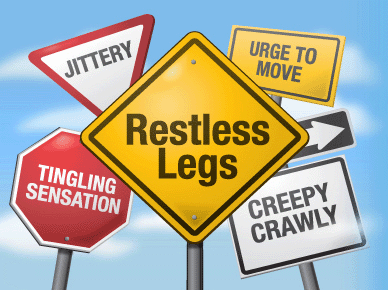As the weather turns colder in Shawnee and the days grow shorter, some changes in the body simply come with the season. Muscles tighten up a little more, we move around a little less, and long nights can feel even longer when sleep doesn’t come easy. For people living with restless leg syndrome, these seasonal shifts can quietly make the condition harder to deal with.
Restless legs are tough any time of year, but winter brings a different kind of challenge. Routines fall out of sync, bedtime stretches feel more uncomfortable, and symptoms can start to interfere with rest more often. That’s why understanding how winter affects the body, and why it matters, can make a real difference when exploring options for restless leg syndrome treatment in Shawnee.
How Cold Weather Can Affect Nerve and Muscle Behavior
When cold air settles in, the body adjusts in ways that aren’t always easy to notice at first. But these changes can cause real discomfort, especially for people already dealing with nerve sensitivity or muscle tension.
• Lower temperatures often cause muscles to tighten and become less flexible, making it harder for the body to stay calm when it’s time for sleep
• Nerves may become more reactive in the cold, which can increase the leg tingling or crawling sensation that restless leg syndrome is known for
• Outdoor time usually drops in the winter, and that reduced movement can make nighttime symptoms worse when the body hasn’t burned off enough energy during the day
Because RLS is connected to both the nervous system and physical motion, these shifts in muscle flexibility and nerve response can make the condition feel more intense or unpredictable during colder months.
Disrupted sleep is one of the most common side effects of this. When legs feel jumpy or uncomfortable, staying in one position long enough to fall asleep becomes a challenge. And once sleep is short or broken, the cycle tends to continue night after night, especially when daily movement stays low.
Why Winter Routines Make Restless Legs Harder to Ignore
By November, daylight is limited and schedules are jammed with end-of-year obligations. That change in rhythm can quietly throw the body off balance.
• Early sunsets and fewer daylight hours can make it harder to stay active after work or school, leading to less movement overall
• Heartier meals and snack-heavy evenings can change digestion and sleep rhythms, both of which are linked to how the body experiences discomfort at night
• Holiday stress, packed calendars, or school breaks can create more sleep interruptions or shifts in bedtime routines
When regular patterns are lost (things like daily walks, regular bedtimes, and calm evenings), the body has a harder time preparing for rest. For people with RLS, where “calm” is already hard to achieve, these changes make the symptoms more noticeable.
Missed cues from the body can add to the frustration. A restless evening might be chalked up to late meals, extra screen time, or stress. But if it keeps happening and legs feel twitchy or uncomfortable more nights than not, it’s probably not just the season pulling the strings.
Signs It’s Time to Look Into Treatment
Sometimes people live with restless legs for years before realizing there’s a pattern to their discomfort. When the cold months roll in and symptoms get worse, it may be the push needed to stop guessing and start looking for answers.
Here are a few signs the condition might need more attention:
• Frequent tossing and turning, especially during the first hour in bed
• Leg twitching that wakes you up or keeps you from falling asleep
• A rising sense of dread or frustration around bedtime
• The urge to move the legs when lying still, especially in the evening
These are real signs that restful sleep is being disrupted. If any of this feels familiar, it could be time to consider how restless leg syndrome treatment in Shawnee might help stabilize nights during the colder season.
Some people notice their symptoms die down in the spring, but that doesn’t mean the problem disappeared. When it comes back next year, or earlier, it brings the same cycle of poor rest and body discomfort. That pattern doesn’t have to keep repeating.
The Role of a Trusted Sleep Specialist in Managing RLS
Sleep issues look different in every person. What brings discomfort for one person might barely bother another. That’s why speaking with someone trained in sleep patterns can be helpful, especially when symptoms come and go with weather or schedule changes.
A sleep specialist looks at the bigger picture. They may start by asking when symptoms show up, how long they last, and what other patterns are happening around them. From there, tools like a sleep study or activity tracking can provide insight that’s hard to gather alone, especially when symptoms mostly show up at night.
At Sweet Sleep Studio, we offer in-office and virtual visits to fit Shawnee residents’ schedules. Our team specializes in affordable in-home sleep studies and develops a plan specific to your lifestyle and the changes each season brings.
Once there’s a clearer picture, it becomes easier to guide next steps. These can include simple changes to sleep habits, structured adjustment plans, or other methods personalized to the individual’s experience.
Cold weather may throw off many routines, but smart planning and consistent care can keep symptoms from getting out of hand. It’s often not about solving everything at once. It’s about building habits that keep the nights calm, even during the hardest stretch of the year.
Getting Back Control as the Seasons Change
Late fall and early winter have a way of sneaking up on sleep routines. What felt manageable in October can feel much tougher by Thanksgiving. And when symptoms build quietly, it gets easier to lose sleep without even realizing how much it’s affecting the rest of the day.
This is a good moment to pause and pay attention. If restlessness at night keeps growing and the old tricks aren’t cutting it anymore, it may be the right time to check in with a sleep specialist and ask what else could be going on.
Understanding what your body needs during colder months won’t fix RLS overnight, but it can keep small problems from turning into bigger ones. And when nights feel more regular, the rest of the day can follow with less stress, more energy, and clearer focus.
At Sweet Sleep Studio, we know how sudden cold weather in Kansas City, Shawnee can make restless legs more challenging at night. Noticing changes in your sleep is an important step toward relief. We work with you to identify patterns so you can understand what your body needs as the seasons shift. To discover helpful solutions, start by exploring how we approach restless leg syndrome treatment in Shawnee. Reach out when you’re ready to have a conversation.




